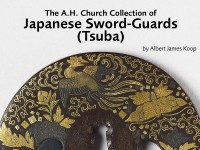The A. H. Church Collection of Japanese Sword-Guards (Tsuba)
An unpublished catalogue of the A. H. Church collection of Japanese sword-guards (tsuba) by Albert James Koop.

Publications online: 1264 objects
Tsuba with wood grain decoration and plaited rim
-
Literature notes
Hamidashi type; seppadai (or irregular profile) in plain shibuichi; rest of field veneered (flush with seppadai) with dark mokume of shibuichi, copper and shakudō; rounded border (bent to allow for the kozuka hole) covered with a harlequin plait of wide strips of silver, sentoku and shakudō; kōgai-hole, in form of a double-gourd bottle with bent neck, lined with shibuichi (probably to conceal the raw edges of the veneer).
An almost exact duplicate of this guard (with silver on the border, however) is in the collection of Dr. W. L. Hildburgh, F.S.A., lent to the Victoria and Albert Museum. A Similar example (1.87" by 1.15", the sides incurved for both hitsu) was given by Sir Arthur Church to the V.A.M. in 1911; in this the veneers cover the seppadai and are visible at the tang-hole, while the plaiting is much finer and includes copper. Beyond these three, I know of no other examples of this peculiar but attractive type of guard. -
Details
- Associated place
- Date
- 18th century (1701 - 1800)
- Material and technique
- shibuichi, with mokume veneer in shibuichi, copper, and shakudō; rim of plaited silver, sentoku, and shakudō; shibuichi kōgai-hole rim; tang-hole plugged with soft metal, probably copper
- Dimensions
- 6.1 x 4.2 cm (height x width)
- Material index
-
processed material › metal › alloy › copper alloy › shibuichi,processed material › metal › alloy › silver alloy › shibuichi,processed material › metal › alloy › copper alloy › shakudō,processed material › metal › alloy › sentoku
- Technique index
- Object type index
-
arms/armour › koshirae › kodogu › tsuba
- No. of items
- 1
- Credit line
- Bequeathed by Sir Arthur H. Church, 1915.
- Accession no.
- EAX.11189
-
Further reading
Koop, Albert James, The A. H. Church Collection of Japanese Sword-Guards (Tsuba), 3 vols (Oxford, Ashmolean Museum, 1929), no. 1189
Glossary (4)
sentoku, shakudō, shibuichi, tsuba
-
sentoku
A kind of brass made from an alloy of copper, zinc, and tin.
-
shakudō
alloy of copper and gold, patinated to a dark blue-black colour
-
shibuichi
alloy of copper and silver, patinated to a dull grey-green colour
-
tsuba
Japanese sword guard.
Location
-
- currently in research collection
Objects are sometimes moved to a different location. Our object location data is usually updated on a monthly basis. Contact the Jameel Study Centre if you are planning to visit the museum to see a particular object on display, or would like to arrange an appointment to see an object in our reserve collections.
Publications online
-

The A. H. Church Collection of Japanese Sword-Guards (Tsuba)
Hamidashi type; seppadai (or irregular profile) in plain shibuichi; rest of field veneered (flush with seppadai) with dark mokume of shibuichi, copper and shakudō; rounded border (bent to allow for the kozuka hole) covered with a harlequin plait of wide strips of silver, sentoku and shakudō; kōgai-hole, in form of a double-gourd bottle with bent neck, lined with shibuichi (probably to conceal the raw edges of the veneer).
An almost exact duplicate of this guard (with silver on the border, however) is in the collection of Dr. W. L. Hildburgh, F.S.A., lent to the Victoria and Albert Museum. A Similar example (1.87" by 1.15", the sides incurved for both hitsu) was given by Sir Arthur Church to the V.A.M. in 1911; in this the veneers cover the seppadai and are visible at the tang-hole, while the plaiting is much finer and includes copper. Beyond these three, I know of no other examples of this peculiar but attractive type of guard.
Notice
Object information may not accurately reflect the actual contents of the original publication, since our online objects contain current information held in our collections database. Click on 'buy this publication' to purchase printed versions of our online publications, where available, or contact the Jameel Study Centre to arrange access to books on our collections that are now out of print.
© 2013 University of Oxford - Ashmolean Museum

